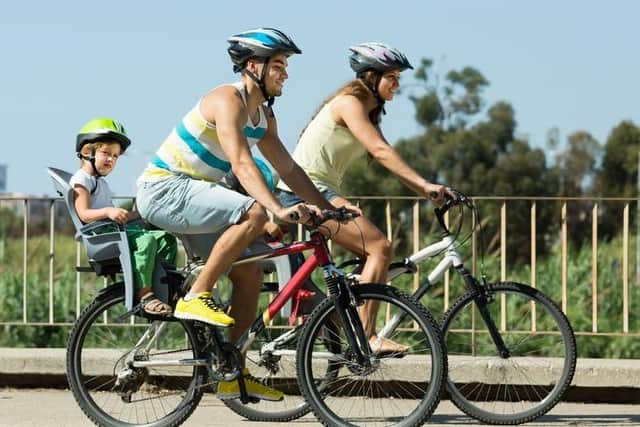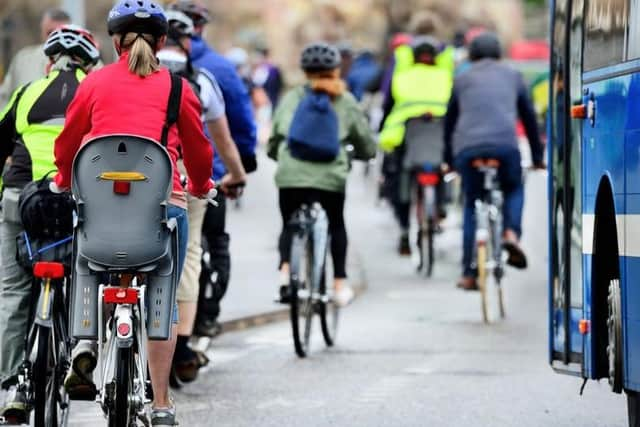Big appetite among motorists for more regulation of cycling
and live on Freeview channel 276
The survey, commissioned by InsuretheGap.com, a leading provider of Guaranteed Asset Protection (GAP) insurance, finds that 70 per cent think electric bikes should have an annual safety test, like an MOT, and 59 per cent agree that push bikes and electric bikes should have a registration number.
Almost three-quarters (74 per cent) of drivers say cyclists should have third party liability insurance, and almost half (49 per cent) think that cyclists should pay a road tax. 84 per cent of drivers say helmets should be a legal requirement.
Advertisement
Hide AdAdvertisement
Hide AdElectric bikes are becoming increasingly common on the roads.


According to the Bicycle Association, e-bike sales doubled between January to October 2020, accounting for one pound in every five spent on bikes. Electric bikes’ motors must have a maximum power output of 250 watts and should not be able to propel the bike when it is travelling at more than 15.5mph.
According to the survey, 84 per cent of drivers also want laws to apply equally to cyclists and drivers. For example, at the present time, cyclists are exempt from Breathalyser laws, and speeding cyclists can only be booked for ‘cycling furiously’, or for ‘wanton and furious driving’ under the Offences Against the Person Act if they cause bodily harm to any person.
Ben Wooltorton, Chief Operating Officer, InsureTheGap.com, said: “It’s clear that drivers have concerns about how cyclists and cars can share the roads; however many drivers are also cyclists, and it’s in everyone’s interest that roads are as safe as possible.
Advertisement
Hide AdAdvertisement
Hide Ad“In fact, over half (55 per cent) of drivers would like more cycle lanes, and two fifths (42 per cent), rising to two thirds (64 per cent) of under 34s, would cycle more if there were more cycle lanes.


“Perhaps it’s time to re-evaluate road usage and how it’s changed in recent years to see if improvements could be made, particularly when the government is about to embark on a massive road expansion and upgrading policy.”
The survey, carried out by Opinium in February of this year, was a response to the growing number of cyclists taking to the roads with concerns for safety in ever more congested traffic situations.
Cycling safety has been a core element of primary school education through the Cycling Proficiency Scheme which has been in Northern Ireland schools for 45 years, and seen 450,000 pupils participate.
Advertisement
Hide AdAdvertisement
Hide AdHowever, the concern now is for better integration for both children and adults as transport options expand and the Government’s 2018 publication, ‘National Standard for Cycle Training’ provides a statement of competent cycling and cycling instruction.


The National Standard aligns with established standards including those for driving and riding motorcycles and mopeds that underpin driver and rider training. The 21-page document can be downloaded from the UK government website.
The publication is the guidance for the ‘Bikeability’ courses in Britain and ‘Sustrans’ in Northern Ireland, where cycle training is just one element of the charity’s involvement with cyclists and pedestrians.
In the Republic, ‘Cycle Right’ is a similar national standard for cycle training. In all cases, the courses are designed to cater for all age groups and all ability levels.
The National Standard:
Advertisement
Hide AdAdvertisement
Hide Ad• is a comprehensive guide to cycling well, not a mandatory pre-requisite for cycling
• focuses on how well people cycle, not how many or how often people cycle
• recognises that other interventions also encourage cycling, including education, engineering and enforcement
• is competence based, describing the skills and understanding required to cycle well
Advertisement
Hide AdAdvertisement
Hide Ad• includes observable performance (‘I can’ statements) and demonstrable comprehension (‘I understand’ statements)
• aims to increase clarity, minimise duplication, and reduce inconsistent interpretation
• provides the basis for a range of different cycle training programmes, including Bikeability
• supports the development of learning resources and other communications to help riders cycle well
Advertisement
Hide AdAdvertisement
Hide AdIn Northern Ireland, all the ‘Sustrans’ cycling instructors are fully qualified to National Standard.
They all have Access NI clearance, first aid training and receive regular Continuous Professional Development courses.
The organisation can provide a one-off training session, extended course or bespoke programme to suit individual needs and budgets.
While some of the survey’s findings may court controversy, it certainly provides food for thought for all road users, that safety for all rests on the individual.